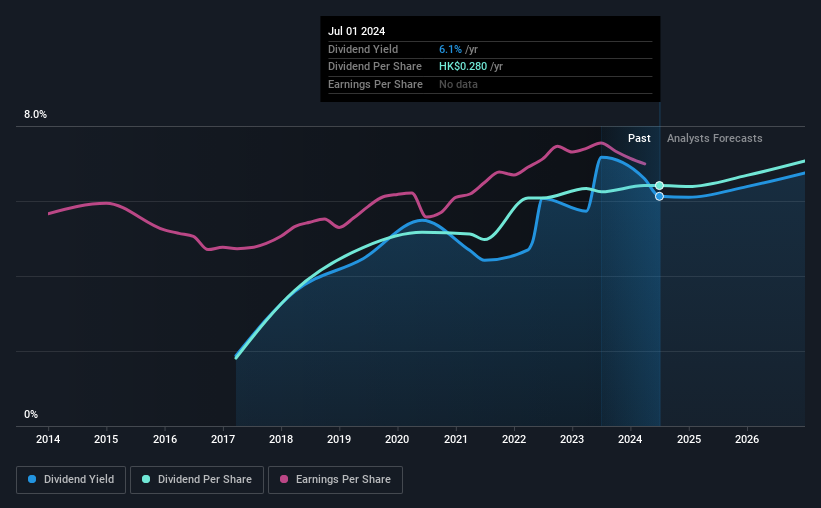Postal Savings Bank of China's (HKG:1658) Shareholders Will Receive A Bigger Dividend Than Last Year

Postal Savings Bank of China Co., Ltd.'s (HKG:1658) dividend will be increasing from last year's payment of the same period to CN¥0.286 on 8th of August. Despite this raise, the dividend yield of 6.1% is only a modest boost to shareholder returns.
View our latest analysis for Postal Savings Bank of China
Postal Savings Bank of China's Earnings Will Easily Cover The Distributions
Even a low dividend yield can be attractive if it is sustained for years on end.
Having paid out dividends for 7 years, Postal Savings Bank of China has a good history of paying out a part of its earnings to shareholders. Based on Postal Savings Bank of China's last earnings report, the payout ratio is at a decent 32%, meaning that the company is able to pay out its dividend with a bit of room to spare.
Over the next 3 years, EPS is forecast to expand by 17.9%. The future payout ratio could be 30% over that time period, according to analyst estimates, which is a good look for the future of the dividend.

Postal Savings Bank of China Doesn't Have A Long Payment History
Postal Savings Bank of China's dividend has been pretty stable for a little while now, but we will continue to be cautious until it has been demonstrated for a few more years. The annual payment during the last 7 years was CN¥0.0737 in 2017, and the most recent fiscal year payment was CN¥0.261. This works out to be a compound annual growth rate (CAGR) of approximately 20% a year over that time. It is always nice to see strong dividend growth, but with such a short payment history we wouldn't be inclined to rely on it until a longer track record can be developed.
The Dividend's Growth Prospects Are Limited
Some investors will be chomping at the bit to buy some of the company's stock based on its dividend history. Earnings have grown at around 4.7% a year for the past five years, which isn't massive but still better than seeing them shrink. Earnings growth is slow, but on the plus side, the dividend payout ratio is low and dividends could grow faster than earnings, if the company decides to increase its payout ratio.
In Summary
Overall, this is a reasonable dividend, and it being raised is an added bonus. The dividend has been at reasonable levels historically, but that hasn't translated into a consistent payment. The dividend looks okay, but there have been some issues in the past, so we would be a little bit cautious.
It's important to note that companies having a consistent dividend policy will generate greater investor confidence than those having an erratic one. At the same time, there are other factors our readers should be conscious of before pouring capital into a stock. As an example, we've identified 1 warning sign for Postal Savings Bank of China that you should be aware of before investing. Looking for more high-yielding dividend ideas? Try our collection of strong dividend payers.
If you're looking to trade Postal Savings Bank of China, open an account with the lowest-cost platform trusted by professionals, Interactive Brokers.
With clients in over 200 countries and territories, and access to 160 markets, IBKR lets you trade stocks, options, futures, forex, bonds and funds from a single integrated account.
Enjoy no hidden fees, no account minimums, and FX conversion rates as low as 0.03%, far better than what most brokers offer.
Sponsored ContentNew: Manage All Your Stock Portfolios in One Place
We've created the ultimate portfolio companion for stock investors, and it's free.
• Connect an unlimited number of Portfolios and see your total in one currency
• Be alerted to new Warning Signs or Risks via email or mobile
• Track the Fair Value of your stocks
Have feedback on this article? Concerned about the content? Get in touch with us directly. Alternatively, email editorial-team (at) simplywallst.com.
This article by Simply Wall St is general in nature. We provide commentary based on historical data and analyst forecasts only using an unbiased methodology and our articles are not intended to be financial advice. It does not constitute a recommendation to buy or sell any stock, and does not take account of your objectives, or your financial situation. We aim to bring you long-term focused analysis driven by fundamental data. Note that our analysis may not factor in the latest price-sensitive company announcements or qualitative material. Simply Wall St has no position in any stocks mentioned.
Have feedback on this article? Concerned about the content? Get in touch with us directly. Alternatively, email editorial-team@simplywallst.com
About SEHK:1658
Postal Savings Bank of China
Provides various banking products and services for retail and corporate customers in the People’s Republic of China.
Flawless balance sheet and fair value.
Similar Companies
Market Insights
Community Narratives




